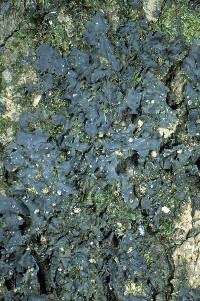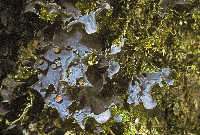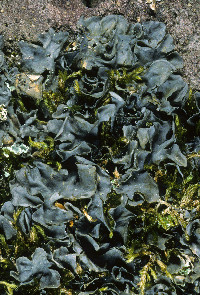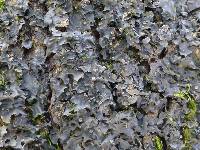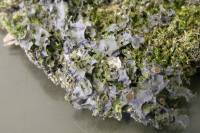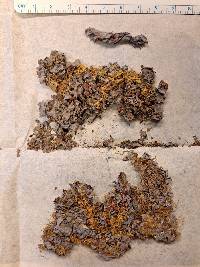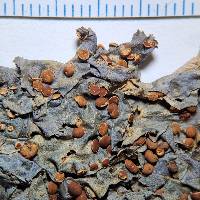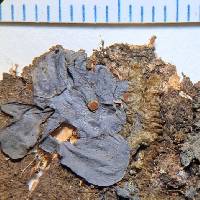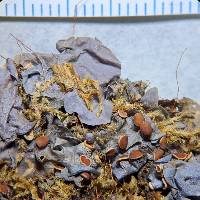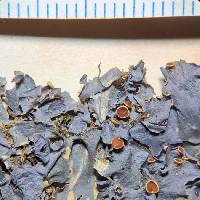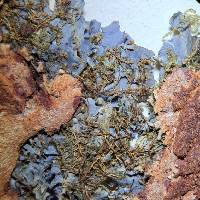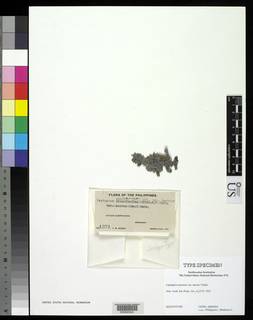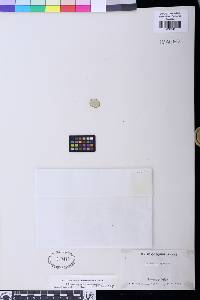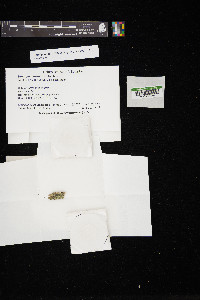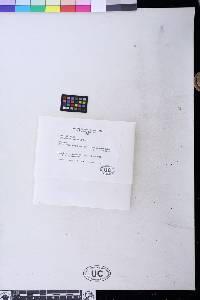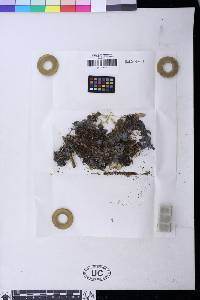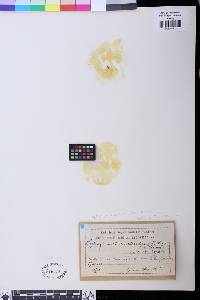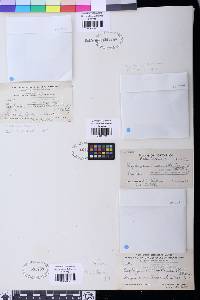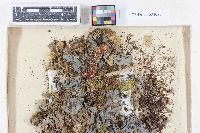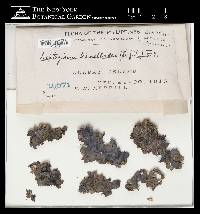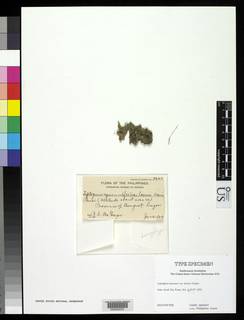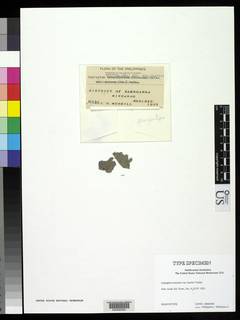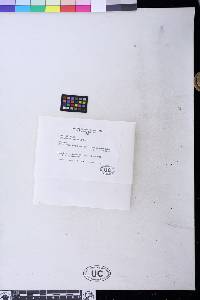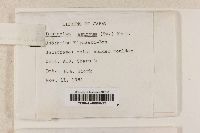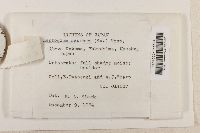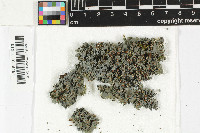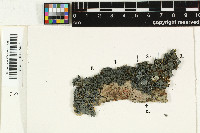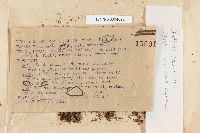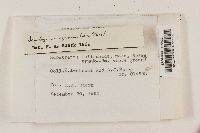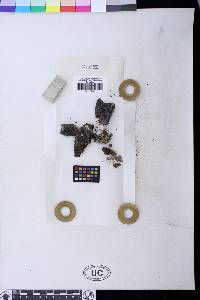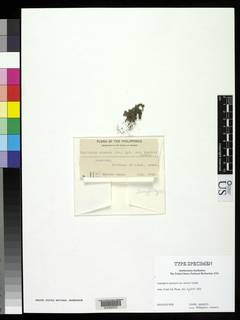
- Home
- Search
- Images
- Species Checklists
- US States: O-Z >
- US National Parks
- Central America
- South America
- US National Parks
- Southern Subpolar Region
|
|
|
|
Family: Collemataceae
[Collema azureum (Sw.) Ach., moreLeptogium moluccanum var. azureum (Sw.) Asahina, Leptogium tremelloides var. azureum Nyl., Lichen azureus Sw., Parmelia azurea (Sw. ex Ach.) Ach.] |
Hist. nat. Iles Canar. 3(2): 129 (1840). Thallus slate gray to grayish black when dry, olive when wet, foliose, adnate, papery thin; outline ± orbicular; lobes distinct, elongate, ± broadened and flattened, regularly spreading (fan-shaped); surface smooth to barely striate, but not distinctly wrinkled, dull; lacking isidia; apothecia common, sessile to shortly stalked, laminal, expanded; disk pale to deep reddish brown, initially concave, flattened with age; margin lecanorine, concolorous with thallus or slightly pallid, with a broad paraplectenchymatous outer thalline exciple and an inner, indistinct, thin, prosoplectenchymatous proper exciple; ascospores ellipsoid to subfusiform, submuriform, 3-5 transversely, and (0)-1 longitudinally septate, 15-28 x 7-10 μm. Substrate & Ecology: A common species throughout the humid vegetation of islands with higher elevations, most typical in the Scalesia-zone; typically on bark, rarely also on leaves or soil (humus), occasionally on rock. Distribution: New to Galapagos, currently known from Floreana, Isabela, Santa Cruz, and Santiago. Notes: A broad lobed species with sessile apothecia and no isidia, at first glance similar in appearance to L. cyanescens, which roughly has the same size, but is typically densely isidiate and rarely develops apothecia. Easily confused with L. punctulatum, another species that is very similar in size and overall appearance lacks isidia and is typically fertile. Leptogium punctulatum, however, has a two-layered thallus with numerous pits that correspond to attachment points where the two layers adhere to one another. Leptogium azureum was originally confused with L. cochleatum, but all Galapagos specimens lack a distinctly paraplectenchymatous inner exciple and broad paraplectenchymatous hypothecium. Instead the proper exciple and hypothecium of all specimens is thin and prosoplectenchymatous. Specimens examined: Floreana Island: 560 m, on Psidium, Itow 9 (L-40713), COLO no. 192200. Isabela Island: Volcán Alcedo, outer SE-exposed slope and crater rim, 0˚27’29”S, 91˚7’19”W, 1089 m, moist upland; disturbed by former grazing of goats therefore scattered trees (Tournefortia rufo-sericea, Zanthoxylum fagara), on bark of Tournefortia rufo-sericea. Santa Cruz Island: ca. 1 km SE of Puntudo, 0˚39’12”S, 90˚19’58˚W, 673 m, fern-sedge zone with dominant Pteridium arachnoideum, Polypodium spp., Thelypteris oligocarpa, on dead leaves of Pteridium arachnoideum on the ground, 1 Feb 2006, Ziemmeck 547, CDS no. 27105; Tras del Puntudo, ex finca de Don Benito, 0˚38’23”S, 90˚19’57”W, 732 m, Zona húmeda, sobre corteza de Scalesia penduculata, altura al pecho, 3 Feb 2007, Nugra 383, CDS no. 35138. Santiago Island: outer S-exposed slope of Cero Gavilan, 0˚12’22”S, 90˚47’6”W, 815 m, fern-sedge zone; non-wooded summit pampa with Portulaca oleraceum, Ageratum conyzoides, Cyperus virens, Digitaria ciliaris, basalt boulders and outcrops, on bark of Croton, 23 Mar 2006, Aptroot 65537, CDS no. 32126. from: Nash, T.H., Ryan, B.D., Gries, C., Bungartz, F., (eds.) 2004. Lichen Flora of the Greater Sonoran Desert Region. Vol 2. Thallus: foliose, 2-9 cm in diam., adnate, subdichotomously to irregularly lobate lobes: irregular, elongate, +plane, separate, 1-5 mm wide, (50-)80-100(-150) µm thick; apices: rotund, entire to lobulate, occasionally upturned upper surface: bluish gray to medium gray, usually dull, smooth to somewhat roughened but not wrinkled, not isidiate internal anatomy: with upper and lower cortices consisting of a single layer of irregularly isodiametrical cells 5-9 µm in diam., internally with loosely interwoven chains of Nostoc and hyphae lower surface: pale to medium gray, wrinkled, with scattered tufts of white hairs Apothecia: common, laminal, sessile to short stipitate, 0.2-2.5 mm wide disc: light brown to red-brown, concave to plane margin: thalline, concolorous with the thallus or cream-colored, entire or occastionally with microphylline outgrowths exciple: euparaplectenchymatous, often poorly developed centrally but up to 35 µm thick marginally hymenium: hyaline below and thinly brown above, 90-150 µm tall; paraphyses: unbranched, 1-2 µm wide, slightly inflated apically; subhymenium: yellow to pale brown, 35-70 µm thick asci: cylindrico-clavate, 8-spored ascospores: hyaline, submuriform, 3-5-septate transversely, 0-1-septate longitudinally, ellipsoid to subfusiform, 14-26 x 6-9 µm Pycnidia: not observed Spot tests: all negative Secondary metabolites: none detected. Substrate and ecology: on bark and sometimes acidic rocks World distribution: widespread, pantropical, extending into some temperate regions in North and South America, Australasia, Asia and Africa Sonoran distribution: Baja California Sur and Sinaloa. Notes: Leptogium azureum is a characteristically blue-gray, large-lobed species, which, when lobulate, may be confused with L. cyanescens, a thinner, more gray species with at least with some coralloid isidia, though sometimes also some lobules occur. |
|
|
|

![Leptogium azureum (Sw. ex Ach.) Mont. [Bungartz, F. 4117 (CDS 28100)] Leptogium azureum image](/imglib/lichens/CDS_Lichens/00028/CDS_28100_DX_0267_print_1555697519.jpg)

